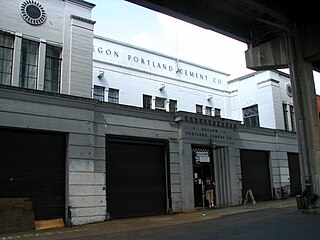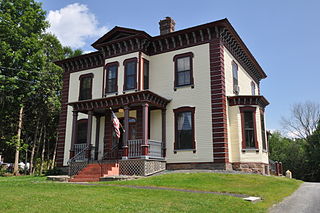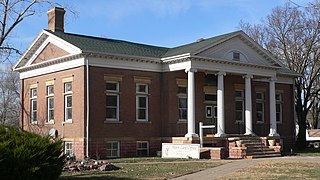
Yankton is a city in and the county seat of Yankton County, South Dakota, United States.
Portland is a town in the Central Tablelands of New South Wales, Australia. At the 2016 census, Portland had a population of 2,424 people. The town was named after Australia's first cement works.

Oxford station was a historic train station at South Elm and West Spring Streets in Oxford, Ohio. Oxford first received railroad service in the 1850s, when a line connecting the Chicago and Cincinnati rail networks was completed through the city. The original station was replaced by a larger building in 1895. Before the rise of the automobile, the station's passenger services brought students to and from Oxford's multiple colleges, including Miami University, and its freight services shipped local agricultural products to their markets. A building known as the Junction House, located across the street from the depot, was built in 1860 and is closely associated with the railroad. Originally a grocery store, it became a hotel and tavern in 1868; while a local temperance movement closed the tavern in the 1870s, it remained a hotel until 1905 and is now an apartment building.

The Public Service Building is a historic 67.06 m (220.0 ft), 15-story office building in downtown Portland, Oregon, United States. The building and its attached parking garage have been listed on the National Register of Historic Places as the Public Service Building and Garage since 1996. It was built to house the offices of the Portland Gas and Coke Company and the Pacific Power and Light Company. The building's name reflects the fact that these utilities were "public services". A space in the Public Service Building fronting the corner of Salmon and Sixth streets became the first Niketown store.

The Roberts Riverwalk Urban Resort Hotel, formerly the Parke-Davis Research Laboratory also once known as Building 55-Detroit Research, is a luxury hotel on the Detroit International Riverfront in Detroit, Michigan. The former research facility was redeveloped as a boutique luxury hotel in the 1980s. The building was designated a National Historic Landmark in 1976 for its historic significance as an early research laboratory.

The Portland Hotel was a late-19th-century hotel in Portland, Oregon, United States, that once occupied the city block on which Pioneer Courthouse Square now stands. It closed in 1951 after 61 years of operation.

The Chicago, Milwaukee and St. Paul Depot in Yankton, South Dakota was built in 1905 by the Chicago, Milwaukee, St. Paul and Pacific Railroad.

There are nine historic districts in Meridian, Mississippi. Each of these districts is listed on the National Register of Historic Places. One district, Meridian Downtown Historic District, is a combination of two older districts, Meridian Urban Center Historic District and Union Station Historic District. Many architectural styles are present in the districts, most from the late 19th century and early 20th century, including Queen Anne, Colonial Revival, Italianate, Art Deco, Late Victorian, and Bungalow.

William Christmas Knighton was an American architect best known for his work in Oregon. Knighton designed the Governor Hotel in Portland, Johnson Hall at the University of Oregon, and the Oregon Supreme Court Building and Deepwood Estate in Salem. He served as Oregon's first state architect from 1911–1915, appointed by Governor Oswald West. By 1915, Knighton had designed ninety building projects as state architect. In 1919, Knighton was appointed by Governor Ben Olcott as the first president of the Oregon State Board of Architectural Examiners, a position he held until 1922. In 1920, Knighton was elected the sixth president of the Oregon Chapter of the American Institute of Architects. He remained on the chapter's board of trustees for several years and was chair of the Chapter Legislative Committee into the 1930s.

The Oregon Portland Cement Building is a building in southeast Portland, Oregon listed on the National Register of Historic Places.

The Multnomah Hotel, located in downtown Portland, Oregon, United States, is a historic hotel building listed on the National Register of Historic Places. It currently operates as the Embassy Suites by Hilton Portland Downtown.

Coplay Cement Company Kilns, also known as the Saylor Park Industrial Museum, is an open-air historic site located at Coplay, Pennsylvania in Lehigh County, Pennsylvania. The nine kilns were built between 1892 and 1893 and used for the production of Portland cement.

Saint John the Baptist Church, commonly known as Lakeport Church, is a stone church located in rural Yankton County in the state of South Dakota in the Midwestern United States. It was built in 1884 and served a predominantly Czech Catholic parish until 1903. In 1980, it was listed in the National Register of Historic Places.

The Colby Mansion is a historic house on Vermont Route 100 in Waterbury, Vermont. It was built in 1870 by George J. Colby, a proponent of ideas of house construction for healthy living, and exhibits all of the major features of his published works. It was listed on the National Register of Historic Places in 1979.
Peter J. Linhoff (1877-1954) was an American architect who designed many houses in St. Paul, Minnesota. He also designed the William J. Fantle House in Yankton, South Dakota, which is individually listed on the National Register of Historic Places (NRHP).

The Yankton Carnegie Library is a historic building in Yankton, South Dakota. It was built as a Carnegie library in 1902–03, and is Neoclassical style in style. It was built by German-born contractor August Goetz. It was a public library from 1903 to 1973.
August Goetz was a building contractor based in Yankton, South Dakota who is credited with constructing many churches, public buildings, and houses throughout the state. Several of his works are listed on the National Register of Historic Places (NRHP).
Tate Arms, also known as the Charles and Dorothy Alberts House and the Williams Hotel, is a historic building located in Iowa City, Iowa, United States. The University of Iowa started to admit African American students in the 1870s, but they were rare before the 1910s. The university constructed dormitories in the 1910s, but they did not allow African Americans to live in them until 1946. Completed in 1914 for Charles and Dorothy Alberts, this house was Iowa City's first rooming house that was built for black tenants and owned by black landlords. Charles Alberts was a stonemason and he operated a cement block manufacturing business. He might have built the house himself. The first black university student started to reside here in 1920. The building was acquired by local attorney Edward F. Rate, who was white, in the 1920s and he continued to rent to African Americans. From c. 1928 to c. 1932 the house was known as the Williams Hotel after its proprietor James Williams, who also owned a car wash.

The Railway Exchange Building is a historic building in Portland, Oregon, also known as the Oregon Pioneer Building. The structure houses the restaurant Huber's.



















